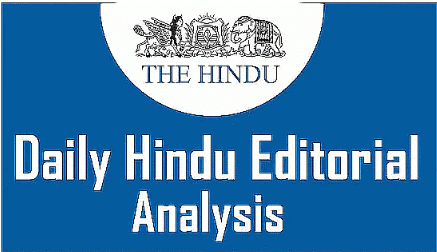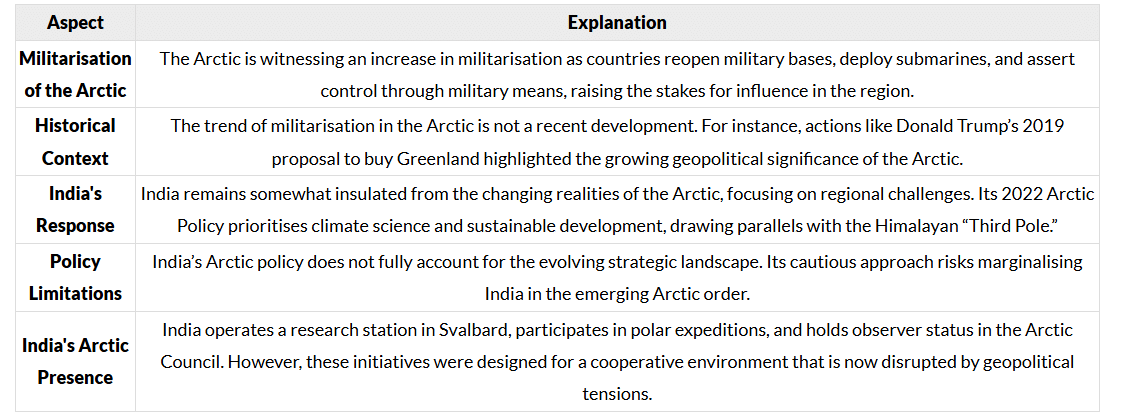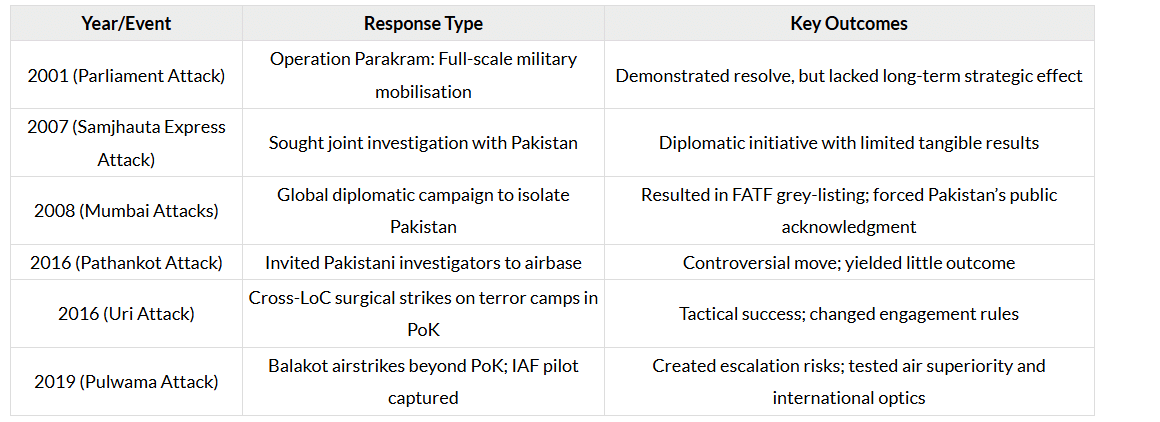The Hindu Editorial Analysis- 5th May 2025 | Current Affairs & Hindu Analysis: Daily, Weekly & Monthly - UPSC PDF Download

India must rethink its Arctic outlook
Why is it News?
The increasing militarization of the Arctic region necessitates a new approach from New Delhi, India.
Introduction
The Arctic, once regarded as a zone of scientific collaboration and environmental safeguarding, is now transforming into a battleground for military and geopolitical rivalry. This shift is fueled by several factors:
- Climate Change: The impact of climate change has made new maritime routes, such as the Northern Sea Route (NSR), more accessible. What was once a seasonal passage is now open year-round, significantly increasing traffic and altering global trade patterns.
- Geopolitical Competition: Countries like Russia, China, and the United States are intensifying their focus on the Arctic. Russia is becoming more assertive in its claims, China is expanding its ambitions in the region, and the U.S. is renewing its interest, particularly in areas like Greenland.
As a result, the Arctic is moving to the forefront of global power competition. The combination of military buildup and changing environmental conditions is reshaping the strategic landscape of the region.
A Growing Militarisation

A Constructive Role for India
- Viability of the Northern Sea Route (NSR): As the NSR becomes more viable due to climate change and increased accessibility, trade flows may shift northward. This could diminish the significance of traditional sea lanes in the Indian Ocean, impacting India’s strategic interests.
- Arctic Sea Routes and Connectivity: If Russia and China establish dominance over Arctic sea routes, India’s aspirations to develop a connectivity hub in the Indo-Pacific could face substantial challenges. Initiatives like SAGAR (Security and Growth for All in the Region) and IPOI (Indo-Pacific Oceans Initiative) may be undermined.
- Blurring Maritime Boundaries: The growing cooperation between Russia and China in the Arctic, coupled with China’s expanding naval presence in the Indian Ocean, complicates India’s focus on its southern maritime interests. This blurring of boundaries makes it harder for India to maintain a clear strategic focus.
- Nordic States’ Concerns: Increasing apprehension among Nordic countries regarding India’s ties with Russia, particularly in the context of the Ukraine conflict, adds pressure to India’s Arctic diplomacy. Nordic states may view India’s partnership with Russia as a potential threat to their interests.
- Reassuring Arctic Partners: To navigate these challenges, India needs to reassure its Arctic partners that its approach, based on strategic autonomy, can be mutually beneficial. This involves demonstrating that India’s involvement in the Arctic is not merely self-serving but contributes to regional stability and cooperation.
A More Purposeful Engagement
To adapt to the changing dynamics in the Arctic, India should consider the following steps:
- Institutionalisation: Expand Arctic engagement beyond scientific collaboration by establishing dedicated desks in the Ministry of External Affairs and the Ministry of Defence. Regular inter-agency consultations and partnerships with strategic think tanks can enhance India’s Arctic policy framework.
- Partnerships: Collaborate with like-minded Arctic states on dual-use initiatives such as polar logistics, maritime domain awareness, and satellite monitoring. This approach can boost India’s credibility in the region without raising concerns among other stakeholders.
- Governance and Diplomacy: Claim a seat at emerging Arctic governance forums focused on infrastructure development, shipping regulation, digital standards, and the blue economy. Engage with local communities in the Arctic region respectfully, avoiding an extractive mindset and ensuring that India’s presence is beneficial to local populations.
Conclusion
While India’s current Arctic posture has its merits, it is no longer adequate in the face of evolving geopolitical realities. The belief that scientific cooperation and climate diplomacy can bridge growing geopolitical divides is becoming increasingly implausible. The Arctic is now more defined by power dynamics than by principles. Countries that fail to adapt to this new reality risk being excluded from the emerging Arctic order.
Not revenge or retaliation, but a paradigm shift Why is it News?
Converting the Line of Control (LoC) into an International Border is seen as a practical solution to address Pakistan's ongoing proxy war against India.
- The recent Pahalgam terror attack on April 22 has prompted a new strategic response from Delhi and Islamabad, drawing the attention of the security community.
- This attack, the deadliest civilian assault since 2008, involved brutal tactics aimed at terrorizing Indians, destabilizing Kashmir's economy, and inciting communal tensions across the country.
- Unlike previous attacks, this one was precise and planned, raising the need for a robust response from India.
Introduction
The Pahalgam terror attack on April 22 has pushed Delhi and Islamabad onto a new strategic path, demanding the attention of the entire security community. As the deadliest civilian attack since Mumbai 2008, its brutality — including religious profiling and executions — aims to terrorise Indians, destabilise Kashmir’s economy, and fuel communal tensions nationwide. Unlike past “fidayeen” missions, this assault was precise, with a planned exfiltration. While a full probe is pending, India has responded with diplomatic steps like suspending the Indus Waters Treaty (IWT) and authorising the military to plan a response operation.
A response that is not just revenge
Strategic Goal
- Craft a long-term response to terror attacks that:
- Goes beyond revenge or retaliation
- Acts as a short-term deterrent
- Alters cross-border patterns and behaviour in the long run
Step 1: Study Past Indian Responses
To design an effective strategy, evaluate which past responses best served India’s national security.
Step 2: Evaluate the Pahalgam Attack Context
- Seen as a deliberate provocation, unlike earlier attacks
- Likely pre-planned exfiltration, not a “fidayeen” attack
- Aims to:
- Terrorise civilians
- Disrupt Kashmir’s economic recovery
- Incite communal tensions across India
Step 3: Required Response Strategies
Indian planners must move beyond past templates. Three distinct yet coordinated strategies are required:
Counter-Terror Strategy
- Enhance intelligence penetration
- Target infrastructure and networks facilitating cross-border terrorism
- Strengthen internal coordination
Retaliatory Strategy
- Execute precision and asymmetric operations
- Maintain element of surprise
- Consider economic, cyber, and covert options
Counter-Counter Strategy
- Anticipate Pakistan’s retaliation spectrum
- Prepare diplomatic, military, and narrative management responses
- Build international support and redundancy
Step 4: Watch for 3 Strategic Wild Cards
1. Pakistan’s Military Leadership – Gen. Asim Munir
- Advocates escalatory doctrines, referencing:
- A "hard state" framework
- Revival of the "two-nation theory"
- Kashmir as the "jugular vein"
- Background and motivations:
- Commissioned during Zia-ul-Haq’s radical phase (1986)
- Promotes the ideology of “Jihad fi Sabeelillah”
- Under pressure to avenge the Jaffar Express attack (March 2025)
- Faces internal pressure due to Imran Khan’s lingering popularity
- Will remain powerful until at least 2027 under amended Pakistani law
2. China’s Role
- Must factor in China's response if India’s action impacts:
- The China-Pakistan Economic Corridor (CPEC)
- Broader China-Pakistan strategic alignment
3. Indian Political Pressure
- Increasing calls in India for:
- A "decisive war"
- "Cartographic changes" through territorial capture in PoK
- Risks:
- Overreaction could lead to strategic miscalculations
- Might close diplomatic space and invite international scrutiny
The diplomatic road ahead

LoC as the border
- Time to reconZsider the idea of turning the LoC into a formal border, a proposal abandoned two decades ago.
- Pakistan's military has exploited the LoC’s permeability and temporary status to conduct proxy warfare.
- The LoC serves as a route for recruiting, training, and infiltrating terrorists into India.
- The TRF claimed the Pahalgam attack was meant to resist “demographic changes” in Jammu & Kashmir.
- On its side, Pakistan has already altered demographics in PoK by settling non-Kashmiris and army personnel.
- Gilgit-Baltistan has been integrated federally, making it difficult for India to govern, even if taken by force.
Conclusion
- It is essential to declare the end of Rawalpindi’s ‘jugular vein’ theory and its aspirations of reuniting the now fragmented regions of Jammu and Kashmir or annexing the Kashmir Valley.
- New Delhi must reconsider the 2007 LoC agreement proposals, which aimed to transform the Line of Control (LoC) or ceasefire line into a de-facto border, eventually leading to its recognition as a permanent International Border.
- The international community’s role, if any, would be to ensure that Pakistan commits to this arrangement — if it seeks to promote a lasting equilibrium in the region.
|
38 videos|5288 docs|1117 tests
|
FAQs on The Hindu Editorial Analysis- 5th May 2025 - Current Affairs & Hindu Analysis: Daily, Weekly & Monthly - UPSC
| 1. What are the key reasons for India to rethink its Arctic outlook? |  |
| 2. How does climate change affect India's interests in the Arctic? |  |
| 3. What role does India play in Arctic governance and cooperation? |  |
| 4. What are the potential economic benefits for India in the Arctic region? |  |
| 5. How can India address the environmental challenges posed by its Arctic engagements? |  |





















